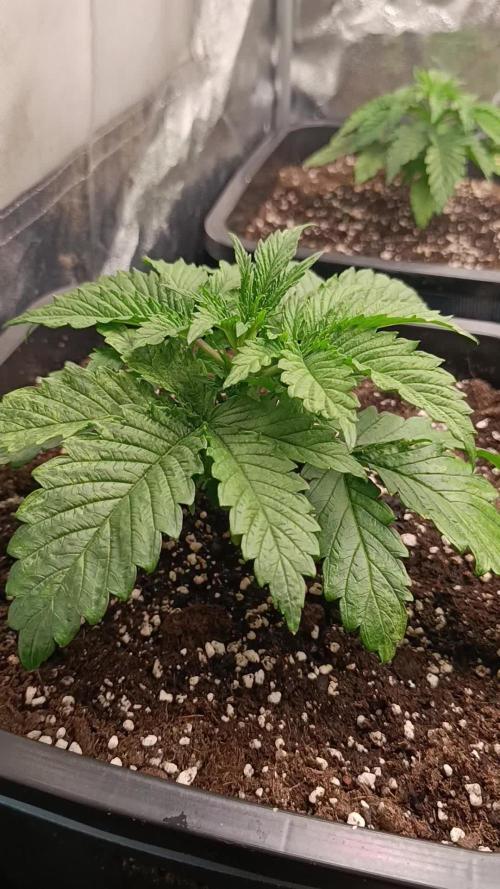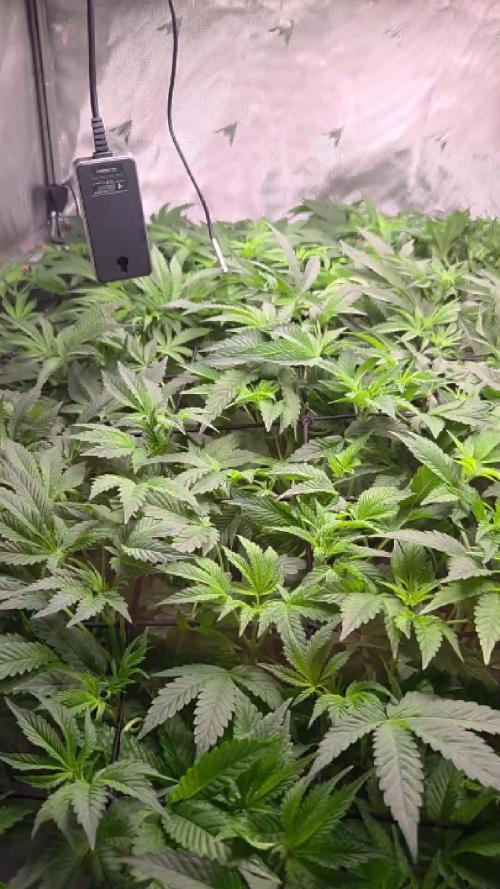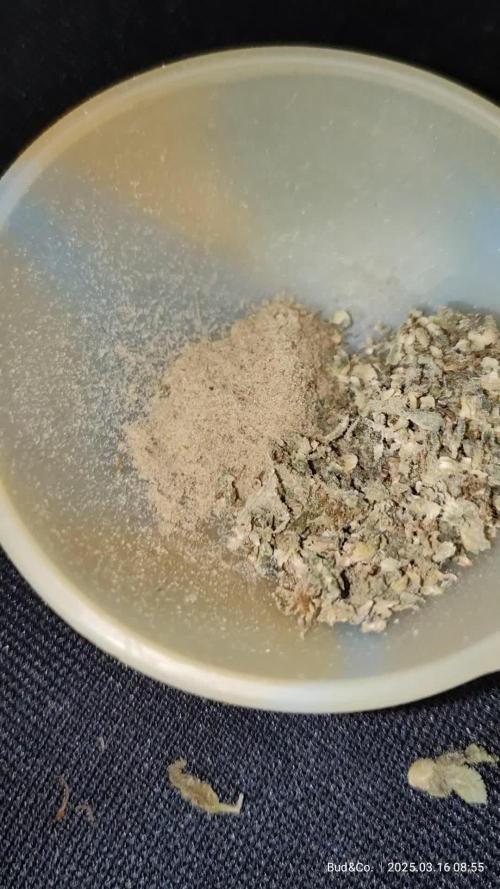The Grow Awards 2026 🏆 



































Likes
Comments
Share


@Budophile
Follow
Day 15: Stretching way faster than anticipated.. Gonna have to tweak the hangers soon because I'm almost at their limit to raise the lamps anymore. Should have lollipopped/defoliated more in the last training session, hope I'll have the courage to go a bit further the next one in about 3-5days which is going to be the last before harvesting. Buds are finally starting to form and dang it looks like a decent haul IF all goes well. No closeup shots will be presented before the frost starts to kick in. I'm cutting down the Bio-Grow gradually and raising the Bio-Bloom at the same time. Thinking about dropping the Bio-Grow entirely at around week 4 of flowering and starting to blast the girls with some decent amount of PK instead.
Day 16: Watered each plant with 2l of nutrient solution and upped the dosage of Bio-Bloom to 3ml/l because of 2 strains were showing some P deficiency on the lower leaves (PC/SS)
Day 18: Did the biggest and most gruesome lollipopping/defoliation session I've ever dared to. Promised myself this would be the last but it does seem like I still have to grow some balls to trim them bitches once more in a week or so IF they respond well to this torture. Slight P deficiency still on the Peyote Criticals and Sunset Sherbets so I'm going to full send it the next time watering and go straight for the 4ml/l on Bio-Bloom. Next week of flowering I'm going to bring the big guns in and start giving them some Atami Bloombastic to make them buds really swell up.. or die trying!
Day 20: Watered each plant with 2l of nutrient solution and this time I went for the full 4ml/l of Bio-Bloom. Only one of the Peyote Criticals was still showing an ever so slight lack of phosphorous so we'll see how they like the full dosage. The bigger GSC had two pretty pale green older fan leaves (not yellowing but still..) so she received 3ml/l of Bio-Grow instead of 2ml/l to keep her going for about 2 more weeks before I can tolerate a little lack of N and let the leaves fall out on their own. Usually I stop giving grow nutes at around halfway of blooming. Don't know if it's just psychosomatic but I do feel abundant nitrogen in late bloom will make the buds taste a bit harsher and give a little headache no matter how good you flush if you keep going on the "full schedule" till the end.
All the buds have a nice little sugar coating forming up and the smell in the tent is becoming nice and fruity. Not sure yet which one of them will be the cream of the crop but everyone looks very promising. OG Kush went through a thorough macro close up session and no visible male flowers are forming anywhere so I might just be able to keep her in the cabin but I'm still prepared to chop her off IF she goes full on Bangkok ladyboy on me. If all goes well this might very well turn out to be my best harvest with this setup so far so I do hope I won't fuck up anything now.
Likes
Comments
Share


@Catawbiense
Follow
Die 5 Frosted Guavas stehen stabil in 18L Gold Label. Eine ist etwas kleiner, deshalb wird erst nach Ankunft der Mars Hydro E3000 getoppt, damit sie vorher aufholen kann. Zusätzlich stehen 2 White Raspberry Truffle als Backup im Zelt.
Beleuchtung läuft mit ~195 W (2× Honguan auf 50 %, Hortione auf ~70%). Der Wuchs ist kompakt und gesund.
Sobald die neue Lampe hängt, werden alle gleichzeitig getoppt für einen gleichmäßigen Canopy.
Mehr Updates folgen ✌️🌱
Likes
12
Share


@PacoMendoza420
Follow
Strong start for week 8, last week of veg. Pretty impressed by these mix of nutrients, total recovery and explosive growth right after watering. And they are totally Bio!
Day 55, I did top feeding with worm castings, nitroguano and amino perlas. Tomorrow I'll switch to 12/12 light cycle and start flowering stage.
The vegetation stage for Mimosa Evo it's been awesome, althought every single plant grew very different from the others showing opposite phenotypes
Likes
4
Share


@RBGreenry
Follow
On flush, not sure why most has finished up first even though it's rather level
Likes
14
Share


@MrGoonai
Follow
07/06/2025 - Day 98
Short Facts:
- 86 cm tall
- VPD @ 1.0
- Approx. 900 PPFD
- Fungus gnats still there
- Thrips seen
------------------------------------------------------------------------
Sorry for not updating the diary over the past few weeks. I had a medical emergency in the family, which caused quite a bit of chaos.
There’s not much to report — her flowers are getting bigger and bigger. The smell is really special and intense!
It looks like senescence is starting. She has lost some color in her leaves and is now turning more yellow. Just to be safe, I added a small amount of Epsom salt.
And of course, there are still problems:
The fungus gnats are still around, although there are far fewer than before. I’d say their numbers are down by about 80% compared to the peak, so at least some progress has been made. I’m still fighting them and have ordered more predatory mites.
Unfortunately, I also noticed some leaves that didn’t look good, so I took a closer look. The result: I found thrips on both plants. It doesn’t look like a full-blown infestation yet, so I hope I can get it under control. The predatory mites should help, and I’ve also ordered some green lacewing larvae to support the fight and hopefully wipe them out.
This whole situation is really frustrating. I recently had to deal with thrips on one of my biggest Alocasias, and I’ve been battling a persistent aphid infestation on my largest Dieffenbachia for weeks now.
I’ve never had this many issues with pests before.
Likes
93
Share


@LGreen
Follow
🌿 Schönen Sonntag & einen entspannten 1. Advent aus der richtigen Zeitzone =)
🌱 Wochenupdate
Diese Woche wurde echt viel gefummelt 😄 Im Fokus standen Canopy-Aufbau und selektives Entlauben =)
Bin da wirklich pingelig und könnte das den ganzen Tag machen… echt schlimm 😅
Was ich jetzt schon sagen kann: Blueberry Cupcake hat mit Abstand den krassesten Stretch hingelegt.
Purpz hat ihren Platz auch relativ gefüllt, performt echt gut und ist fast gleichauf mit BBCC.
Notorious zieht auch, soll aber wohl etwas später definierter drücken. Mir gefällt ihr Wachstum richtig gut.
Guzzlerz macht sich auch echt gut für ihren schlechten Start.
Ihre Sides gehen mittlerweile richtig steil. Ein paar mehr Triebe wären nice gewesen, aber da lag sicher auch einiges an mir.. :D
Abseits meiner Dummheiten lief alles absolut smooth. Eine tolle Veg und richtig gute Stretch-Phase bis jetzt =D🔥
🌿 Pflanzenstatus & Training
Ich halte die Canopy aktuell noch flach – für zwei, drei Tage =) Anschließend steht das Verteilen auf die Meshes an. Danach dürfen sie endlich nach oben =D
Die Richtungen sind grob gelegt, erste Ansätze sieht man auch schon =D Ich kann’s echt nicht erwarten… Budporn ist einfach magisch 😄🔥
Über die Tage sind immer wieder größere oder verdrehte Blätter rausgeflogen – hauptsächlich, um Luft und Licht auf möglichst viele Triebe zu bekommen 😊
Man kann wirklich ohne Bedenken ~30 % Biomasse rausnehmen, wenn die Vitalität das zulässt, ohne sichtbaren Stop im Wachstum 🌱
🌬️ Luft & Ventilation
Hab jetzt noch zwei Clip-Ventis dazugezogen. Die Angst vor Schimmel kickt langsam wieder =D
Es laufen jetzt zwei unter und zwei über der Canopy – jeweils gegenüberliegend und zirkulierend.
Ich muss gestehen, dass ich den Boundary-Layer-Disruption-Effekt kenne bzw. davon weiß, und ihn durchaus stimmig finde 😊 Aber bis jetzt war die Angst vor Schimmel in irgendeiner Ecke doch größer 😂
Ich hab nicht den Eindruck, dass es negativ ist, zirkulierende Luft auf die Pflanzen zu richten, solange man nicht voll draufpustet 💨
⚙️ System
Läuft nach wie vor stabil =) Die Top-Ups halten die Nährlösung sauber auf Kurs.
Gestern hat sich klar abgezeichnet, dass wir mitten im Stretch-Peak sind 😄 Sie ziehen massiv Kationen und verursachen dadurch einen deutlich messbaren pH-Drop.
Das ist für mich das Signal, das Training in den nächsten Tagen zu beenden 🌿😊
800 PPFD
1,0 kPa VPD
700–800 ppm CO₂ im Durchschnitt
💚 Special Mention
Der Aufwärtstrend setzt sich fort 😊 Man mag es kaum glauben, aber sie macht sich wirklich gut – sie deckt sogar etwas mehr als die Hälfte ihres Quadranten ab 💚
Bin echt froh, dass sie es geschafft hat und meinen Scheiß noch mitgetragen hat 😂
Danke fürs Lesen echt verrückt, wie viele inzwischen dabei sind – freut mich wirklich mega 😊💛
Eine schöne, entspannte Adventszeit euch allen 🌲😊
Likes
12
Share


@PEAKYPLANTERS
Follow
HELLO EVERYONE, BROTHERS OF CULTIVATION, WELCOME BACK TO OUR GARDENS....🙌MERRY CHRISTMAS TO ALL OF YOU🙌...THE BABY GIRL IS GROWING WITHOUT PROBLEMS
Likes
24
Share


@Weedzoks
Follow
La plante est passé en 12/12 pour lancer la floraison des féminisées
Flo 8: Arrosage engrais complets et taille secondaires
Flo 12: Arrosage eau
Processing
Likes
30
Share


@Velk1
Follow
All the baby's are in great shape the mbap's are taking to the scrog well loads and loads of bud sites
The grape walker kush are getting nice and big I esspesially like the look of the mainlined/folded one structure is nice and open
Now the gold glue by topping this seems to have really done it well more open branchy structure much Easyer on training this one is going to be interesting ......... Check out the insta for more @velk_1
Likes
6
Share


@BudeCo
Follow
Everything is ok
Growing faster than i wish.
I should defoliation again and put some clips tomorrow.
Need some topping after almost a week.
Its health and fine.
Likes
8
Share


@TheGreenLeopard
Follow
Coming throw - we put a few in a 20liter - going for a few tiers. Tent has opened up some space from harvesting this week so should see the remainders beef up some more. Weird that I have flies in this tent. Harmless but I think the sweet aroma maybe have something g to do with it - or coffee grinds -
Likes
4
Share


@Growstopher
Follow
Fastbuds seeds
LSD-25 auto #2
Only using spring water for first week and spraying with foop mist every night.
Going to be using foop nutrients with Humboldts secret cal/mag and nectar for the gods ph up and down.
Here we go!
Likes
44
Share


@RakonGrow
Follow
Note :
+ jegliches Zubehör wird in der GermniationsWoche aufgelistet . Zeitraffer Videos folgen immer nachträglich.
+ videos werden so geschnitten das nur ein geschlossenes Zelt erscheint , ergo Fehlen paar reale Minuten (ca 1 Std) .
+ + leider ist die Halterung defekt und die Videos etwas schief . Vielleicht mach ich mich irgendwann mal daran und korrigiere das. Sorry
Day 43:
+ Höhe : 64cm
Es wächst und wächst :))
Day 44:
+ Höhe : 65cm
+ 2 Liter Flaschenwasser , kein Dünger .
+ + PH 6.5
+ Drain : PH 7.0
Höhe ist bei 63cm , das ist 3 cm mehr als die Vorgabe ausweisst :))
Day 45:
+ 66cm höhe.
+ 2 Liter Flaschenwasser
+ + Dünger für Blühte
+ + + Canna Terrar Flores (Achtung wirkt wie PH-)
+ + + Canna Boost
+ + + Cannazym
+ + + Greenhouse Feeding BioEnhancer als PH+
Jetzt säuft sie wie wilde , keine 24h und die 2Liter sind komplett wech . Mehr geht aber nicht in den Topf , ergo muss ich mir langsam mal überlegen ob ich Tropfbewässerung nutze .
Und es treten duch das nur Wasser extreme "Calzium" Probleme auf . Hihi , aber so hab ich mal das ganze auf Startsequenze gesetzt . Ich arbeite also noch daran diese Mischung aus BioBizz Light und Urgesteinmehl nach Schätzung zu meistern :)) Den Fakt ist , da ist viel zu viel Urgesteinmehl drinne , was auch die Vegiphase schon gezeigt hat.
Day 46:
+ 1.5 Liter Flaschenwasser
+ + Dünger für Blühte
+ + + Canna Terrar Flores (Achtung wirkt wie PH-)
+ + + Canna Boost
+ + + Cannazym
+ + + Greenhouse Feeding BioEnhancer als PH+
Day 47:
Draussen zu heiss , drinnen zu feucht ... Ja genau was ich nicht brauch lol ...
GoPro aus der Halterung gefallen :))
Day 48:
+ Höhe : 68cm
+ 2 Liter Flaschenwasser
+ + Dünger für Blühte
+ + + Canna Terrar Flores (Achtung wirkt wie PH-)
+ + + Canna Boost
+ + + Cannazym
+ + + Greenhouse Feeding BioEnhancer als PH+
Draussen zu heiss , drinnen naja ... Der Entfeuchter arbeitet weil ich sonst hier Tropenstimmung bekomme :)) Ein wenig Entlaubung .
Day 49:
+ Höhe : 68cm
+ 2 Liter Flaschenwasser
+ + Dünger für Blühte
+ + + Canna Terrar Flores (Achtung wirkt wie PH-)
+ + + Canna Boost
+ + + Cannazym
+ + + Greenhouse Feeding BioEnhancer als PH+
+ + + PH 5.8
+ + Drain PH 6.5
Läuft bei der Lady , sie trinkt , liebt das Licht (auch wenn die Spitze etwas zuviel bekommt , sie betet halt etwas ) , Mangelerscheinungen sind echt gering . Hat die heissen Tage (27° im Zelt bei 60%-57% ) hat sie super überstanden . Ich werde immer besser im Gießen . 75% von oben , 25% lass ich von unten aufsaugen .
Likes
39
Share


@Hazecat_420
Follow
Las altas temperaturas han persistido es por esto que el riego ha sido más seguido variando siempre entre fertilizante y agua. Esta vez ya se utilizó Flawless Finish para este último proceso, una vez secándose el sustrato se comienza con la cosecha. Ha sido un buen cultivo. Veremos como termina esto. Seguimos ! 👽💪
Likes
3
Share


@GoodTimesOrganics
Follow
Die regenerative Phase neigt sich langsam dem Ende zu. Es ist zu beobachten, dass der Pflanzentyp sehr hell in Erscheinung Tritt.
Die Pflanze ist sehr stark von Trichomen überzogen, was dem Namen Ice Cream Haze alle Ehre macht.
Das Aroma einfach überwältigend.💚🍭🍦🐇
Likes
125
Share


@Regenwurm
Follow
Diese Woche ist eine kurze Woche. Die Damen werden jetzt aufgrund ihrer Größe in die Blüte geschickt. Tage der Wachstumsphase = 32 Tage. Größe beim Start Blütephase= 24 cm
Mehr gibt es in diesen paar Tagen nicht zu sagen
Lichtstärke: 50%
Lichtabstand: 40 cm
Std Tag/Nacht: 18/6
Temperatur Tag: 23-24,5 Grad
RLF Tag: 55%
Temperatur Nacht: 20-21 grad
RLF Nacht: 50 %
PH Wert Wasser/Düngelösung: 6,4
EC Wert: 0,15
Ventilator Oszillation: Stufe 1
Befeuchter: aus
Entfeuchter: mit Steuerung an
Bewässerung: 1* Wasser
Controlling: Grow Control
Dünger: Greenbuzz Nutrients
Licht: Pro Emit Vollspektrum
Abluft: EC Carbon Active 750 m3 gesteuert
https://greenbuzznutrients.com/de/
Danke an den Sponsor Greenbuzz
25 % Rabatt bei der Nutzung des Codes auf der GB Homepage
https://greenbuzzliquids.com/de/shop/
Code: GD42025
Likes
7
Likes
33
Share


@microgrowshow
Follow
Start of the journey for the Auto Gelato I am testing for Fast Buds Genetics 💪 .. I messed up and had my light timer turned off, so I ran 24 hours for the first week instead of 20-4, which I believe to be the culprit for the leggy seedling. That, or my light is not sufficient. It says it's 150 W on here, but I can assure you it is only 100 W out of the wall. I had the brightness down originally but brought it up to 85-90% to see if I can stop the stretch.
Likes
19
Share


@Mo_Powers
Follow
she is doing really well. we are at the beginning of week 5. she is currently getting a lot of rain. but also enough sun and daylight. you can clearly see that she is preparing for the flowering phase. i have not used any growing techniques on her. just sunlight and fertiliser.


















